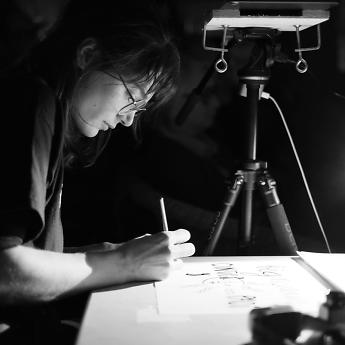
Ladin folk tales
Marmots and the Fanes people
The high plateau of the Fanes Alps, located in the triangle between upper Val Badia, Marebbe and the mountain ranges of Cortina d'Ampezzo, is a barren, stony desert of peculiar charm and austere beauty. The view sweeps across rugged rock slabs and endless streams of scree, with hardly any shrubbery sprouting from the pale ground. Dry as dust, the lunar landscape stretches to the horizon, mirroring a similar scene on the high plateau of the Sella massif – the same wind whistles incessantly over the Gardenaccia area.
For a long time, the valley dwellers – mostly simple farmers – avoided these inhospitable heights, finding them unsettling. They used the mountain pastures as long as they provided meadows and grazing land, only a few brave hunters venturing into the rocky terrain to chase chamois. Occasionally, a shepherd boy would dare to wander into the dark gorges along the slopes, searching for a lost sheep. Stories circulated about witches, fiends, demonic mountain spirits and evil savages known as the Salváns, who were said to inhabit the mountain forests and whom one would do well to avoid. Similar tales emerged in the neighbouring Val Pusteria valley and across Tyrol. Although people in these regions spoke different languages – German or, further south, Italian – they held a fear of witches in common.
In those days, visitors showed little interest in the local people. Sure, their peculiar dialect might have sounded strange, but in the multi-ethnic Habsburg Empire, a colourful mix of languages was nothing out of the ordinary. Although most people couldn’t quite place the language – it sounded somewhat like Romansch but not quite like Italian – it was not particularly exciting to outsiders. In the earliest days of Alpine tourism, those who were very lucky might have met a highly educated Val Badia native from Colfosco who had studied in Bressanone, Trento and Innsbruck and was extremely knowledgeable about the culture of his homeland. His name was Jan Batista Alton (1845–1900), and he published his first studies on the fragmented Ladin language in 1881: Proverbi, tradizioni ed aneddoti delle valli ladine orientali con versione italiana (Innsbruck 1881). Alton’s knowledge of the customs and traditions of his fellow countrypeople was likewise extensive. Moreover, as a passionate mountaineer, he was among a group of like-minded people who, in the 1870s, helped open up the Sella Group to the newly founded German and Austrian Alpine Club. During this period, he achieved several first ascents, including Sas Pordoi and the Cima Pisciadù in 1872.


Not long after, another pioneer of tourism entered the scene: Karl Felix Wolff (1874–1966), a journalist and writer from Bolzano. Writing for major publications across the Austro-Hungarian Empire, Wolff aimed to attract a wealthy audience to the newly discovered wonderland of the Pale Mountains. In 1913, he published the first volume of what would become his famous collection of local legends, Dolomitensagen: Sagen und Überlieferungen, Märchen und Erzählungen der ladinischen und deutschen Dolomitenbewohner (The Dolomites and Their Legends). The book was well-received, and the collection has since grown to over 800 pages; now in its eighteenth edition, it has been translated into numerous languages.
Wolff used the title Dolomitensagen (Dolomite legends) to describe his freely adapted stories, his choice of the term influenced by the region’s burgeoning tourism. He wrote for an international audience familiar with the Dolomites but less knowledgeable about the specifics of Ladin culture. As an engaging piece of literature, the volume was well received. However, when Wolff revealed that the texts he had recorded were essentially half-forgotten remnants of an old Ladin storytelling tradition that Alton had overlooked, experts reacted with open scepticism. The Dolomite legends that he had recorded did not fit neatly into the broader landscape of Alpine legends. The aetiological motifs were too strange, more akin to origin myths, and the Ladin world of mountain spirits was too idiosyncratic, only vaguely reminiscent of the more widely accepted fairies and dwarves, yet unmistakably hinting at numinous ideas.
Interestingly, Jan Batista Alton, a Val Badia native, was apparently unaware of these traditions when he compiled his small volume of Ladin legends and fairy tales. In his brief introduction, he even described Ladin culture as assai mediocre (quite poor) and suggested that most of the stories had been borrowed from German Tyrol. Today, we know that Alton was very much mistaken and that alongside the dozens of legends circulating throughout the Alpine region, Ladinia also had its own unique body of lore that served as a repository of community identity in these remote areas over many generations.
Beyond the typical tales of witches, hauntings and various spirits of dubious hostility, the Ladin-speaking regions harboured stories that remained unknown outside this tradition and bore little resemblance to the usual folklore of the broader Alpine milieu. This difference intrigued collector Wolff, prompting him to investigate further. His research led him to traces of an oral storytelling culture that thrived in the secluded valleys of the Dolomites well into the early 20th century. Wolff described this tradition in his early writings, and other sources have corroborated his accounts.


Then, in 1914, the First World War erupted. By 1915, a brutal conflict had broken out on the Dolomite front, and in the apocalypse of the gran vera – the Great War – the Habsburg Empire of Austria-Hungary was brought to its knees. In 1919, South Tyrol, including the war-torn Ladin Dolomite region, was ceded to Italy. The world became a different place.
Wolff managed to preserve what he gathered before and shortly after the war, but from the 1920s onwards, his notebooks contain fewer entries on newly discovered motifs. They include mostly control questions and increasingly frequent comments like, “...don’t know anything anymore”. Even before the First World War, only a handful of individuals knew these stories well enough to recite them. The community likely enjoyed listening to them and was familiar with the basic outlines. However, after the trauma of the war years, people had more pressing concerns than preserving old traditions. Modernity had arrived, and the rise of tourism was on the horizon…
The tales Wolff found made up a fragmented landscape – a quarry of narrative scraps, pictorial visions and vague memories suggesting that these stories were “older”. Yet, the Dolomite legends aren’t simply “older”; they are “different”. They convey ancient Ladin perspectives on time and history, focusing on the visualisation of Chronos and Kairos – ideas about the “right time” and the fateful balance between chance and necessity. These tales reflect the inevitable cycle of beginning, growth, peak, decline and fall.
Wolff did not invent these legends; he uncovered them – albeit sometimes in heavily distorted and half-forgotten form. Even though he occasionally lost his way in the process, this has long been forgiven. He has preserved a precious treasure trove of ancient tales for us all, and their iconic mythopoesis need not fear comparison with the rich lore of Europe’s advanced civilisations. The legends of the Kingdom of Fanes echo the great enduring themes of world literature. They inspire poetry, fuel new literary works and find expression in the vivid imagery of graphic art, paintings and sculptures.
Ulrike Kindl is a linguist, scholar of popular traditions and former professor at Ca’ Foscari University in Venice. She has studied German, medieval studies and linguistics and since 1980 she has focused her research on folk tales, fables and legends in Alpine areas. She is also a scientific collaborator in the field of popular traditions studies at the “Majon di Fascegn” and “Micurà de Rü” Ladin institutes as well as being a member of the scientific committee of the “Ladinia - Sföi culturâl dai ladins dles Dolomites” yearbook.

NOS. The podcast series from Alta Badia Brand addresses all guests who are interested in learning more about us Ladins, our culture and our traditions. Meet us Ladins up close.


Sweatshirts, caps and T-shirts: the Alta Badia Brand collection delivers a unique touch of the Dolomites to the curious, adventure-seeking and nature-loving guest. Every single piece conveys the feeling of being high up in the mountains, even when you're in the city. So cool!









































